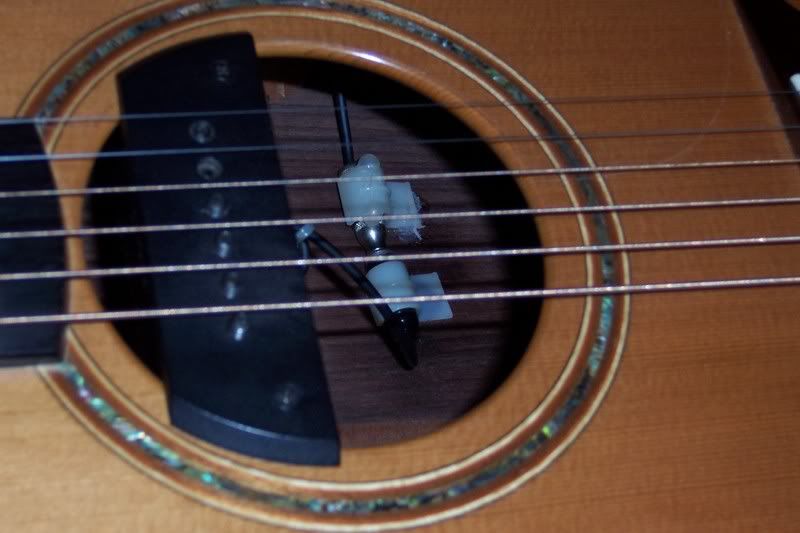I love acoustic guitars. It is amazing what a good luthier can do with a few thin plates of wood, some metal strings, and a few other assorted parts. And it amazes me how much variation there can be in what is a pretty mature art. It is clear that dimensions can only vary so much or you either end up with an instrument that self destructs or one that sounds like a table. The materials chosen also make a significant difference in the end product. You can hear the difference between mahogany and Indian rosewood or even Indian rosewood and Madagascar rosewood. Scale length makes a difference. the size and shape of the body makes a difference. Every little detail is important. It is no wonder that the best guitars are not inexpensive.
Oh... but playing a good one... it is such an intimate experience to wrap the instrument with your arms and coax music from it.
Then comes the problem of playing live. Acoustic guitars are not very loud instruments. Sitting in the living room with friends, they're perfect. Playing on a stage in front of 100 or 1000, they just don't cut it. You need to amplify them. And amplifying an acoustic guitar is always a series of trade-offs between accuracy, feedback rejection, expense, the degree to which the source requires changes in technique, and complexity. You can't get cheap, accurate, with a low feedback threshold. So, the irony is that you spend thousands of dollars for a wonderful acoustic guitar and then have to spend a thousand more to get a good signal to send to an amplifier or PA system.
 Every player will come to his or her own conclusion regarding which trade-offs to make. For me, it is involves two different technologies of pickups. The first is a Sunrise. This pickup represents the same technology that is used in most electric guitar pickups - a magnet wound with wires that senses the movement of the string in a magnetic field. It is an old technology that is fraught with difficulties when used with acoustic guitars, not the least of which is that it tends to sound like an electric guitar rather than an acoustic. In my opinion, the Sunrise is the best magnetic pickup available for an acoustic guitar. It has a touch of the electric sound but only a touch. It also has a huge bass response and is the least likely pickup to feed back of anything out there. It is heavy, expensive, hard to get, and perhaps a bit ugly. By itself, I think it sounds OK. Paired with another source that makes up for its shortcomings, the Sunrise is amazing.
Every player will come to his or her own conclusion regarding which trade-offs to make. For me, it is involves two different technologies of pickups. The first is a Sunrise. This pickup represents the same technology that is used in most electric guitar pickups - a magnet wound with wires that senses the movement of the string in a magnetic field. It is an old technology that is fraught with difficulties when used with acoustic guitars, not the least of which is that it tends to sound like an electric guitar rather than an acoustic. In my opinion, the Sunrise is the best magnetic pickup available for an acoustic guitar. It has a touch of the electric sound but only a touch. It also has a huge bass response and is the least likely pickup to feed back of anything out there. It is heavy, expensive, hard to get, and perhaps a bit ugly. By itself, I think it sounds OK. Paired with another source that makes up for its shortcomings, the Sunrise is amazing. Which brings us to the second source in my guitars, a piezo soundboard transducer affixed to the inside of the top of the guitar. This type of pickup can give a fairly accurate representation of the sound of an instrument. It works when a piezo crystal vibrates and generates an electrical current that is analogous to th vibrations. The downside is that they are extremely sensitive to placement (the photo is probably not the best placement), feedback relatively easily, and pick up every sound including your shirt sleeve sliding across the top of the guitar. My Lowden has a McIntyre in it and my Silver Creek will have a jjb like the photo in it.
Which brings us to the second source in my guitars, a piezo soundboard transducer affixed to the inside of the top of the guitar. This type of pickup can give a fairly accurate representation of the sound of an instrument. It works when a piezo crystal vibrates and generates an electrical current that is analogous to th vibrations. The downside is that they are extremely sensitive to placement (the photo is probably not the best placement), feedback relatively easily, and pick up every sound including your shirt sleeve sliding across the top of the guitar. My Lowden has a McIntyre in it and my Silver Creek will have a jjb like the photo in it.Together the two pickups go to a pre-amplifier and a buffer that refines the sounds even more and I end up with a sound that isn't the same as the guitar acoustically but it is a HUGE sound that I find really pleasing. The irony is that it is a very expensive way to amplify an acoustic guitar and requires a huge amount of technology to sound... old fashioned. In the case of the Silver Creek, the pickups cost about the same as the guitar and when you add in the pre-amps and effects, the electronics are worth way more than the instrument where the sound begins.




No comments:
Post a Comment